Complete CI pipeline
In this document, we will build an complete CI pipeline by integrating Argo Events to the existing CI workflow.
Usually, we should receive events like "Push" from services such as GitHub.
The service must be exposed to public IPs to accomplish this, but since the current test environment has no security-related settings, there is a risk involved.
So in this document, we'll perform GitHub push separately and manually add files to MinIO to trigger the event.
Modify git clone step
In the previous git clone step we only checked the files, but this time we'll read the latest tag and store it in the version.txt file to use it for setting image tags.
If you connect to other services such as GitHub, you can apply this part in another way.
The example repository has tags set up as follows.
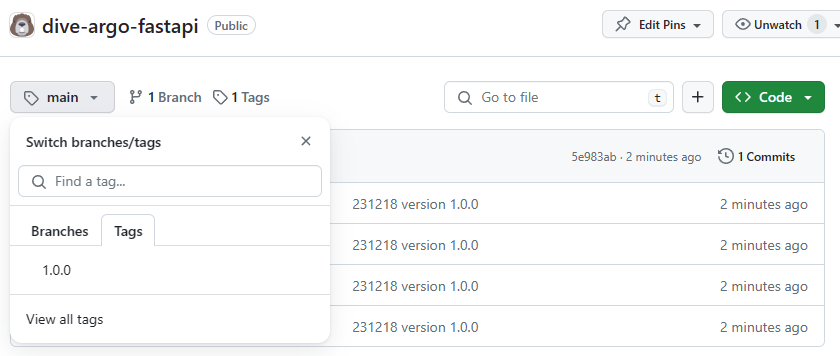
Then, change the existing template as follows.
apiVersion: argoproj.io/v1alpha1
kind: WorkflowTemplate
metadata:
name: git-clone
spec:
serviceAccountName: huadmin
templates:
- name: checkout
inputs:
parameters:
- name: git-url
- name: revision
value: "main"
artifacts:
- name: source-code
path: /code
git:
repo: "{{inputs.parameters.git-url}}"
revision: "{{inputs.parameters.revision}}"
outputs:
artifacts:
- name: source-code
path: /code
parameters:
- name: image-tag
valueFrom:
path: /code/version.txt
script:
image: bitnami/git:2.43.0
workingDir: /code
command: [bash]
source: |
git describe --tags --abbrev=0 > version.txt
After executing the modified workflow, the version.txt file is created, in which you can see the content: which is the latest tag value, 1.0.0.

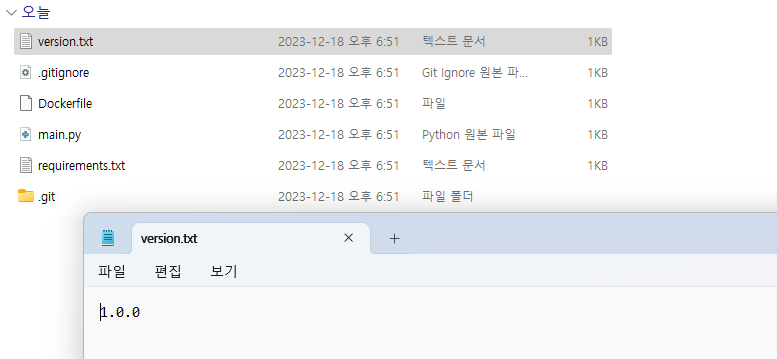
This value and source code is set as output for being used in the following steps.
Auto-change image tag in Helm chart
Now, we'll write an additional workflow to automatically push the image tag to the Helm chart repository after building an image.
Write sample Helm chart
Firstly, currently there's no Helm chart for the sample app, so I created it in a separate repository.
The details of the Helm chart are not discussed here.
https://github.com/BeaverHouse/dive-argo-fastapi-helm
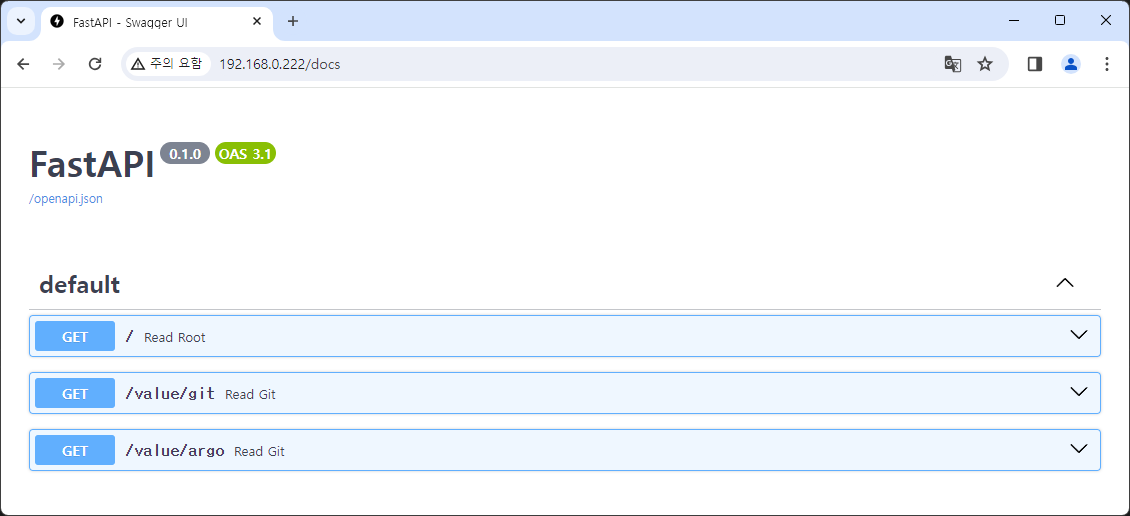
The image above is test deployment of the chart through the ingress controller.
The sample app and Helm chart used here have the base path set to '/'.
If you want to deploy to a different base path, you have to change the settings.
For FastAPI, please refer to the following link.
https://fastapi.tiangolo.com/advanced/behind-a-proxy/
https://stackoverflow.com/q/60397218
Create GitHub token
To modify GitHub source code, related permission is required.
You can control the source by using tokens, without setting up an account.1
You can generate token from the link below.
https://github.com/settings/tokens/new
Set up name and repository permission, then generate a token.

We need to encrypt this token value with base64 encoding.
echo -n <api-token-key> | base64
Use this encrypted value to write a secret in the Helm chart.
apiVersion: v1
kind: Secret
metadata:
name: github-access
type: Opaque
data:
token: <base64-encoded-api-token-from-previous-step>
Apply changes with helm upgrade command.
Write workflow
Now, let's write the actual step to modify the Helm chart.
apiVersion: argoproj.io/v1alpha1
kind: WorkflowTemplate
metadata:
name: chart-push
spec:
serviceAccountName: huadmin
templates:
- name: change-push
inputs:
parameters:
- name: image-tag
- name: github-user
value: "HU-Lee"
- name: repository
value: "BeaverHouse/dive-argo-fastapi-helm"
- name: revision
value: "main"
script:
image: guidoffm/yq-git:latest
env:
- name: GITHUB_TOKEN
valueFrom:
secretKeyRef:
name: github-access
key: token
command: [bash]
workingDir: /code
source: |
git clone https://{{inputs.parameters.github-user}}:$GITHUB_TOKEN@github.com/{{inputs.parameters.repository}}.git --branch {{inputs.parameters.revision}} .
ls
pwd
git config --global user.name "HU-Lee (Argo)"
git config --global user.email "haulrest@gmail.com"
yq e -i '.image.tag = "{{inputs.parameters.image-tag}}"' fastapi-argo/values.yaml
git add .
git commit -m "change image tag to {{inputs.parameters.image-tag}}"
git push origin {{inputs.parameters.revision}}
We should focus on 3 points:
- The API token value should be retrieved from the secret.
- When cloning with git, you need to use the token value in order to control the source code afterwards.
- We edit the
.yamlfile using yq.
Save the workflow and check if the tag is normally changed through testing.
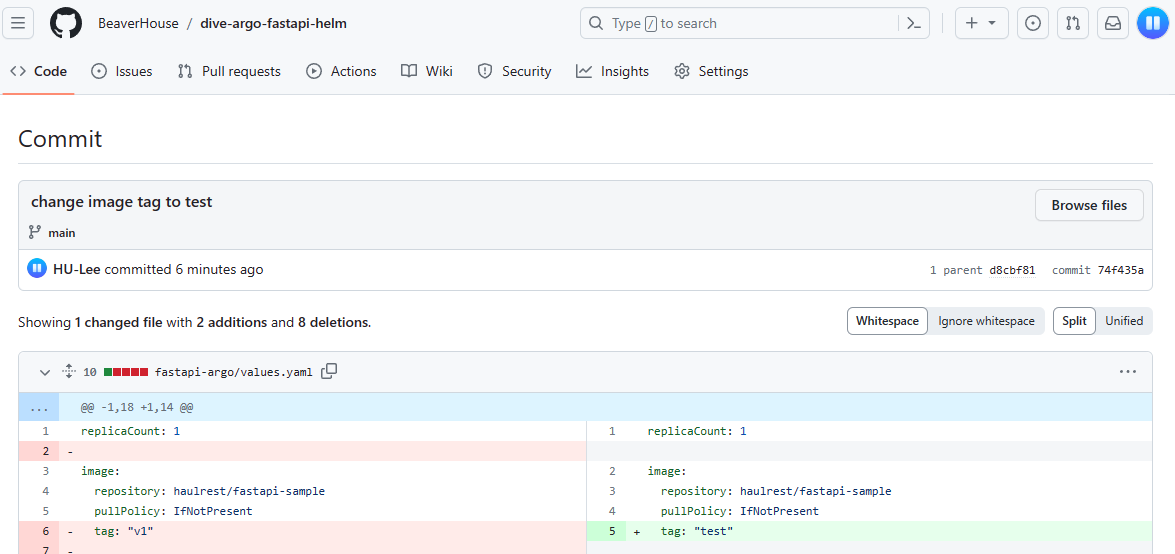
Run entire workflow with sensor
Now, we'll write the entire workflow in sensor file, including all previous steps.
apiVersion: argoproj.io/v1alpha1
kind: Sensor
metadata:
name: argo-ci-sensor
spec:
eventBusName: eventbus-jetstream
template:
serviceAccountName: huadmin
dependencies:
- name: minio-input
eventSourceName: minio-event
eventName: files
triggers:
- template:
name: ci-trigger
k8s:
operation: create
source:
resource:
apiVersion: argoproj.io/v1alpha1
kind: Workflow
metadata:
generateName: argo-ci-
spec:
serviceAccountName: huadmin
entrypoint: total-wf
arguments:
parameters:
- name: git-url
value: https://github.com/BeaverHouse/dive-argo-fastapi
- name: FROM_ARGO
value: from argo-events
- name: image_name
value: fastapi-sample
templates:
- name: total-wf
dag:
tasks:
- name: clone
arguments:
parameters:
- name: git-url
value: "{{workflow.parameters.git-url}}"
templateRef:
name: git-clone
template: checkout
- name: kaniko-process
dependencies: [clone]
arguments:
parameters:
- name: FROM_ARGO
value: "{{workflow.parameters.FROM_ARGO}}"
- name: image_name
value: "{{workflow.parameters.image_name}}"
- name: image_tag
value: "{{tasks.clone.outputs.parameters.image-tag}}"
artifacts:
- name: source-code
from: "{{tasks.clone.outputs.artifacts.source-code}}"
templateRef:
name: image-build
template: build-push
- name: helm-push
dependencies: [kaniko-process]
arguments:
parameters:
- name: image-tag
value: "{{tasks.clone.outputs.parameters.image-tag}}"
templateRef:
name: chart-push
template: change-push
retryStrategy:
steps: 3
The event information will not be used so it was deleted.
Triggered workflow must be executed instantly, so we specify the required values in advance.
After saving, you can check the following event flow.

Test CI pipeline
For testing, generate events through MinIO again.
We can see that the workflow runs normally.
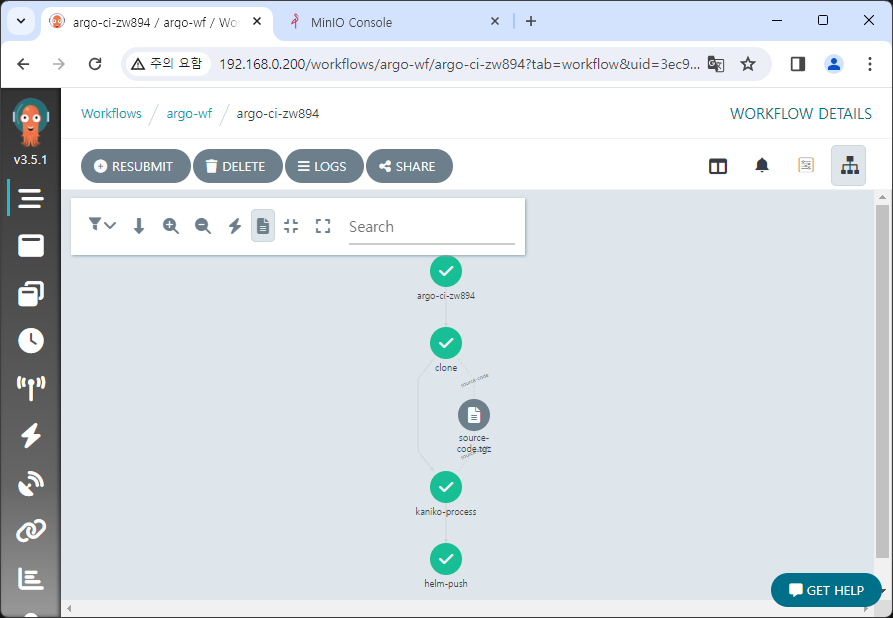
A new image with the tag 1.0.0 has been pushed to Docker Hub as well.

Lastly, we can also see the 1.0.0 value on Helm chart in Github repo.
